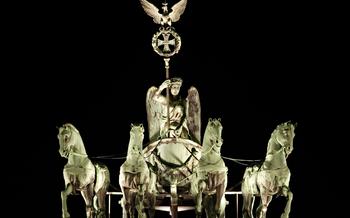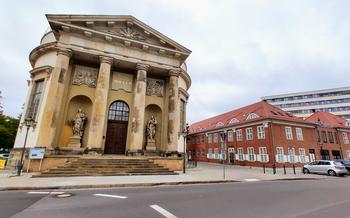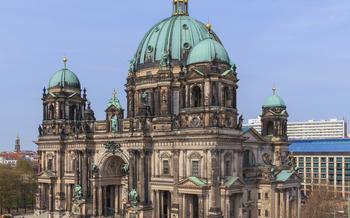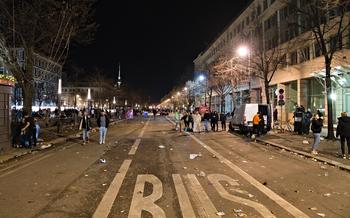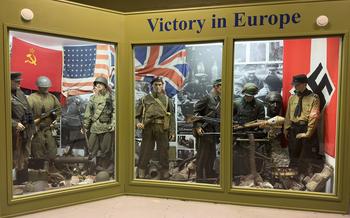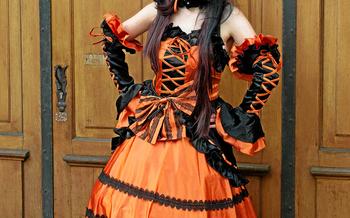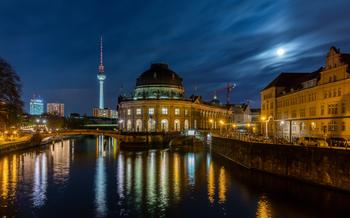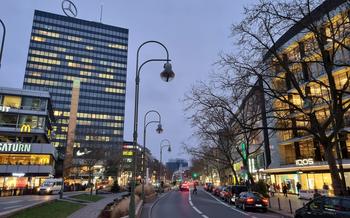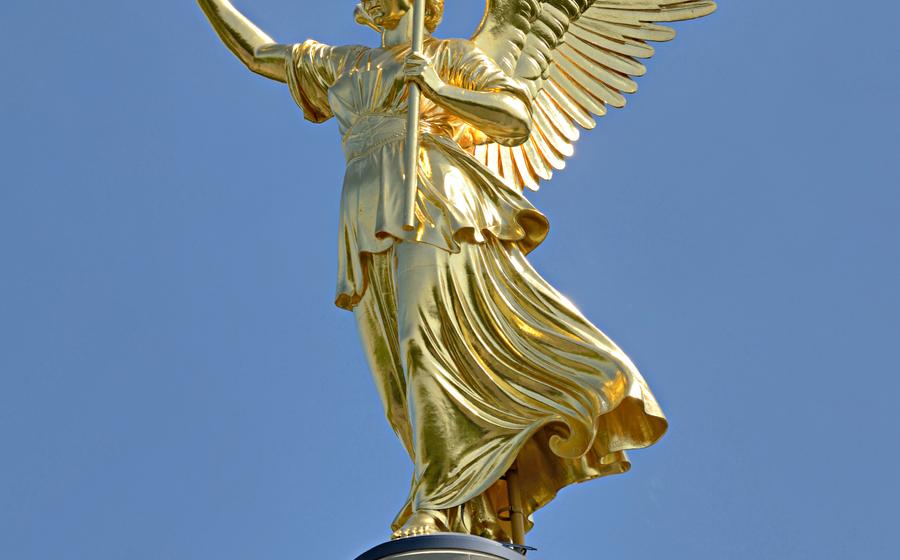
Victory Column
- Historical Significance: A Symbol of Triumph and Unity
- Location: A Haven in the Heart of Berlin
- Golden Victoria: A Symbol of Triumph and Serenity
- Observation Deck: Panoramic Views of Berlin
- War Memorial
- Historical Context of the Franco-Prussian War
- Symbol of German Reunification
- Surrounding Park
- Changing Perspectives
- Restoration and Preservation
- Cultural Significance
- Events and Celebrations
- Practical Information
- Insider Tip:
Historical Significance: A Symbol of Triumph and Unity
The Victory Column, also known as the Siegessäule, stands as a testament to Germany's rich history and military prowess. Its construction was commissioned by Kaiser Wilhelm I in 1864 to commemorate Prussia's victory in the Franco-Prussian War. Designed by architect Heinrich Strack and sculptor Friedrich Drake, the column's foundation was laid in 1865, and it was finally unveiled in 1873 with great fanfare.
The Victory Column stands as a symbol of Germany's unification and the strength of the newly formed German Empire. It represents the culmination of Prussia's efforts to unify the German states under its leadership and the successful outcome of the Franco-Prussian War, which cemented Germany's position as a major European power. The column's dedication to Prussian victories serves as a reminder of the sacrifices made by German soldiers and the triumph that followed.
Location: A Haven in the Heart of Berlin
The Victory Column stands tall in the heart of Tiergarten Park, a sprawling green haven in the heart of Berlin. Its central location makes it easily accessible by various modes of transportation. Take a leisurely stroll through the park, enjoying the tranquil atmosphere and lush greenery, until you reach this iconic landmark. Alternatively, hop on the U-Bahn or S-Bahn and alight at the nearby Tiergarten station. From there, it's just a short walk to the column.
Plan your visit to coincide with a tour of other nearby attractions. The Brandenburg Gate, a symbol of German reunification, is just a stone's throw away. Admire its majestic architecture and learn about its historical significance. Take advantage of the proximity to the Reichstag Building, the seat of the German parliament, and witness the impressive glass dome that crowns this architectural marvel.
Tiergarten Park offers a plethora of other attractions to enhance your visit. Stroll along the tranquil shores of the Neuer See, rent a boat and paddle across its serene waters, or simply relax on the park's lush lawns, soaking in the tranquil ambiance. Explore the Berlin Zoo, home to over 1,500 animal species from around the world, and encounter fascinating creatures up close.
With its central location and proximity to other attractions, the Victory Column is an ideal starting point for exploring Berlin's rich history and culture. Immerse yourself in the city's vibrant atmosphere and create lasting memories in this urban oasis.
Golden Victoria: A Symbol of Triumph and Serenity
At the pinnacle of the Victory Column stands the majestic Golden Victoria, a gleaming symbol of triumph and peace. Towering over 8 meters (26 feet) tall, this bronze statue depicts the Roman goddess Victoria, her wings outstretched as if ready to take flight. With a weight of several tons, the statue exudes an aura of strength and resilience.
Golden Victoria, or Viktoria, as she is fondly called by locals, has become an iconic symbol of Berlin. Her serene countenance and graceful posture evoke a sense of victory and triumph, reminding visitors of the city's rich history and its ability to rise from adversity.
The statue's intricate details and craftsmanship are a testament to the skill and artistry of sculptor Friedrich Drake. From the delicate folds of her drapery to the intricate details of her wings, every aspect of Golden Victoria is meticulously rendered. The statue's golden hue, which is said to have been inspired by the gold captured during the Franco-Prussian War, further enhances its grandeur and significance.
Golden Victoria has become a popular subject of photography and a symbol of Berlin's resilience and triumph. Whether bathed in the warm glow of sunrise, illuminated by the city lights at night, or standing tall against a backdrop of clouds, the statue offers a stunning visual spectacle that captivates visitors from around the world.
Observation Deck: Panoramic Views of Berlin
Ascend the 285 steps of the Victory Column or take the elevator to the observation deck, where you will be rewarded with breathtaking panoramic views of Berlin. From this elevated vantage point, you can survey the city's vast expanse, taking in iconic landmarks like the Reichstag, the Brandenburg Gate, and the TV Tower. On a clear day, you can even see as far as the forested hills surrounding Berlin.
The observation deck offers a unique perspective on the city, allowing you to appreciate its layout and admire its diverse architectural styles. Spot the iconic golden dome of the Reichstag, the sprawling Tiergarten Park, and the modern skyscrapers of Potsdamer Platz. Feel the wind in your hair as you take in the stunning vistas, and savor the feeling of being on top of the world.
War Memorial
The Victory Column also serves as a solemn war memorial, paying tribute to the German soldiers who valiantly fought and sacrificed their lives in the Franco-Prussian War. The monument features bronze plaques that bear the names of these fallen heroes, etched in remembrance of their ultimate sacrifice. These plaques serve as a poignant reminder of the human cost of war and the profound impact it had on the nation.
As you stand before the Victory Column and gaze upon these names, a sense of reverence and gratitude washes over you. You are reminded of the immense sacrifices made by countless individuals who fought for their country, their ideals, and their way of life. Their unwavering dedication and bravery paved the way for the unification of Germany and left an indelible mark on the nation's history.
The Victory Column stands as a symbol of both triumph and remembrance, acknowledging the glorious victories while honoring the sacrifices that made them possible. It is a powerful reminder that peace is often hard-won and that the pursuit of unity and progress can sometimes come at a great cost.
Historical Context of the Franco-Prussian War
To fully grasp the significance of the Victory Column, it's essential to understand the historical context of the Franco-Prussian War. This conflict, which lasted from July 1870 to May 1871, marked a turning point in European history and significantly shaped the political landscape of the time.
The war's roots can be traced to a complex interplay of political rivalries, territorial disputes, and nationalistic sentiments. Prussia, under the leadership of Otto von Bismarck, sought to unify the German states under its rule, while France, under Emperor Napoleon III, feared the growing power of its eastern neighbor.
Tensions escalated when Prussia allied with several southern German states, threatening the delicate balance of power in the region. In July 1870, France declared war on Prussia, initiating a conflict that would forever alter the course of European history.
The Franco-Prussian War was characterized by a series of decisive Prussian victories, largely attributed to their superior military organization, strategy, and technology. Battles such as Sedan and Metz proved pivotal, leading to the capture of Napoleon III and the fall of the Second French Empire.
The war culminated in the signing of the Treaty of Frankfurt in May 1871, which resulted in the unification of Germany under Prussian leadership and the establishment of the German Empire. The victory over France cemented Prussia's dominance and marked a significant milestone in the formation of a unified German nation.
Symbol of German Reunification
After the fall of the Berlin Wall in 1989 and the subsequent reunification of Germany in 1990, the Victory Column took on a new symbolic meaning. Once a symbol of Prussian militarism and imperial ambitions, it now represented the unity and strength of the newly reunited Germany. The column became a popular gathering place for celebrations and national events, a place where Germans could come together and celebrate their shared history and culture. The reunification of Germany marked a turning point in the country's history, and the Victory Column, with its rich historical significance, became a powerful symbol of this historic event.
Surrounding Park
The Victory Column stands proudly in the heart of Tiergarten Park, one of Berlin's largest and most beautiful green spaces. Take a leisurely stroll through the park's lush greenery and serene atmosphere, enjoying the shade of towering trees and the sound of birdsong. Tiergarten Park offers a welcome respite from the hustle and bustle of the city, and provides a tranquil setting for contemplation and relaxation.
Within the park, you can visit other attractions such as the Berlin Zoo, home to over 1,500 species of animals from all over the world. The Soviet War Memorial, a poignant reminder of the sacrifices made by Soviet soldiers during World War II, is also located in the park. Explore the park's many paths and trails, discovering hidden gems and enjoying the tranquility of this urban oasis.
Changing Perspectives
The Victory Column has witnessed changing perspectives over time, reflecting shifting societal attitudes and historical interpretations. Initially perceived as a symbol of Prussian militarism and triumphalism, it gradually evolved into a monument of national pride and unity. After German reunification in 1990, the column took on a new significance, representing the strength and resilience of the newly unified nation.
However, ongoing debates surround the Victory Column's historical significance and relevance in contemporary society. Critics argue that it glorifies militarism and perpetuates a romanticized view of war. Advocates, on the other hand, emphasize its value as a historical artifact and a reminder of Germany's complex past. The ongoing discussions underscore the dynamic nature of historical interpretation and the contested meanings of monuments in shaping collective memory.
Restoration and Preservation
The Victory Column has undergone several restoration and preservation efforts throughout its history to maintain its integrity and grandeur. The most significant restoration took place after World War II when the monument sustained damage from Allied bombings. The golden statue of Victoria was particularly affected, requiring extensive repairs and regilding. In the 1980s, a comprehensive restoration project was undertaken to address structural issues and clean the monument's exterior. The project involved meticulous cleaning, stone repairs, and the replacement of damaged ornamental elements. Ongoing maintenance and conservation efforts are carried out to ensure the Victory Column remains a well-preserved symbol of Berlin's rich history.
Cultural Significance
The Victory Column holds immense cultural significance in Berlin, embodying the city's rich history and heritage. It serves as a poignant reminder of the Franco-Prussian War, symbolizing both the triumph of the Prussian army and the subsequent unification of Germany.
The column has become an iconic landmark, deeply embedded in the fabric of Berlin's identity. Its majestic presence and intricate details have inspired countless artists, writers, and filmmakers to create works that capture its essence and significance.
In literature, the Victory Column features prominently as a symbol of power, pride, and national unity. Theodor Fontane, one of Germany's most celebrated authors, depicted the column in his novel "Effi Briest," using it as a backdrop for scenes that explore the social and political dynamics of the era.
In popular culture, the Victory Column has been featured in numerous films and television shows, often serving as a backdrop for historical dramas or scenes set in Berlin. Its distinctive silhouette and symbolic value have made it a recognizable landmark, both within Germany and internationally.
Beyond its historical and cultural significance, the Victory Column has also become a popular gathering place for celebrations and national events. On special occasions, the column is illuminated with colorful lights, creating a stunning spectacle that attracts locals and tourists alike.
The Victory Column stands as a testament to the resilience and spirit of Berlin, a city that has risen from the ashes of war and division to become one of the most vibrant and cosmopolitan cities in Europe.
Events and Celebrations
The Victory Column has witnessed numerous significant events and celebrations throughout its history. One notable event is the annual Victory Column Festival, held on the last weekend of August. This lively festival features food stalls, live music, and family-friendly activities, attracting locals and tourists alike. The festival provides an opportunity to celebrate the column's historical significance and its role as a symbol of German unity.
Another notable event is the New Year's Eve fireworks display, which takes place near the Victory Column. Thousands of people gather around the monument to witness the spectacular fireworks show, which illuminates the night sky and creates a festive atmosphere. The event is a popular way to ring in the new year and enjoy the company of friends and family.
On special occasions, such as national holidays or sporting victories, the Victory Column is often adorned with flags and decorations. The monument becomes a focal point for celebrations and a symbol of national pride. It is a place where people come together to commemorate important events and share moments of joy and unity.
Practical Information
Opening Hours and Ticket Prices:
The Victory Column is open to the public daily from 9:30 am to 6:00 pm. Admission to the observation deck costs €3 for adults, €2 for students, and is free for children under 6 years old.
Best Time to Visit:
To avoid crowds and enjoy the best views, plan your visit to the Victory Column on a weekday morning or late afternoon. During the summer months, consider visiting early in the day or closer to sunset to avoid the midday heat.
Nearby Restaurants and Attractions:
After exploring the Victory Column, there are several restaurants and attractions nearby to enhance your experience. For a bite to eat, try the Café am Neuen See, which offers a delightful lakeside dining experience. Other nearby attractions include the Berlin Zoo, the Soviet War Memorial, and the Charlottenburg Palace.
Accessibility Options:
The Victory Column is wheelchair accessible via a ramp located on the north side of the monument. An elevator is also available to take visitors to the observation deck.
Insider Tip:
For a unique perspective and a stunning photo opportunity, head to the nearby Café am Neuen See. This charming café offers a picturesque view of the Victory Column across the tranquil waters of the Neuer See. Enjoy a cup of coffee or a delicious meal while admiring the monument from a different angle. As the sun sets, the golden statue of Victoria catches the warm glow of the evening light, creating a magical and unforgettable scene.
